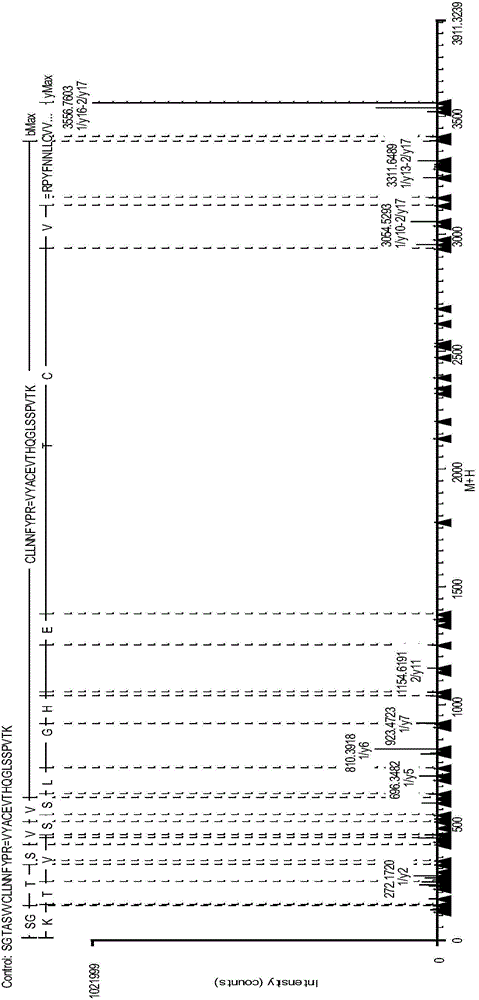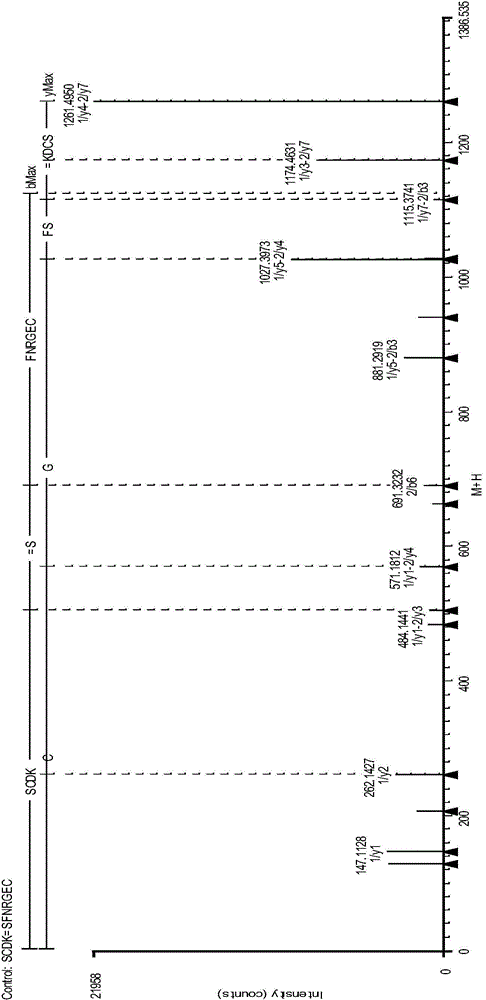Analysis method for disulfide bond pairing of monoclonal antibody
An analysis method, disulfide bond technology, applied in the field of antibody disulfide bond pairing analysis, can solve the inconvenience and other problems, and achieve the effect of fewer enzyme cleavage methods and rich fragment ions
- Summary
- Abstract
- Description
- Claims
- Application Information
AI Technical Summary
Problems solved by technology
Method used
Image
Examples
Embodiment 1
[0045] Example 1: Antibody disulfide bond pairing analysis (trypsin combined with Lys-C digestion)
[0046] Monoclonal antibody disulfide bond pairing analysis steps:
[0047] (1) Protein denaturation treatment
[0048] Take 0.5 mg protein sample and add it to 380 μl denaturation buffer (8M guanidine hydrochloride+5mM EDTA+0.5MTris, pH8.3), mix well, and incubate at 37°C for 60 minutes. Ultrafiltration centrifugation or desalting column desalting to 50mM NH 4 HCO 3 (pH8.0) buffer.
[0049] (2) Enzymolysis
[0050] Take 100 μg of the protein in (1), add trypsin at 1:25 (wt / wt), add Lys-C at 1:200, combine with enzymatic hydrolysis monoclonal antibody, and incubate at 37°C for 4 hours.
[0051] (3) Reduction and termination of enzymatic hydrolysis
[0052] After the enzymatic hydrolysis of the sample in (2) is completed, take half of the sample and add formic acid FA to a final volume concentration of 0.1%; add 1 μL of 0.1M DTT to the other half of the sample volume, and a...
Embodiment 2
[0068] Example 2: Monoclonal Antibody Disulfide Bond Pairing Analysis (Trypsin Digestion)
[0069] Monoclonal antibody disulfide bond pairing analysis steps:
[0070] (1) Protein denaturation treatment
[0071] Take 0.5 mg protein sample and add it to 380 μl denaturation buffer (8M guanidine hydrochloride+5mM EDTA+0.5MTris, pH8.3), mix well, and incubate at 37°C for 60 minutes. Ultrafiltration centrifugation or desalting column desalting to 50mM NH 4 HCO 3 (pH8.0) buffer.
[0072] (2) Enzymolysis
[0073] Take 100 μg of the protein in (2), add trypsin-digested monoclonal antibody at 1:25 (wt / wt), and incubate at 37°C for 4 hours.
[0074] (3) Reduction and termination of enzymatic hydrolysis
[0075] After the enzymatic hydrolysis of the sample in (2) is completed, take half of the sample and add formic acid FA to a final volume concentration of 0.1%; add 1 μL of 0.1M DTT to the other half of the sample, and add formic acid FA to a final volume concentration of 0.1 after...
Embodiment 3
[0080] Example 3: Monoclonal Antibody Disulfide Bond Pairing Analysis (Lys-C Digestion)
[0081] Monoclonal antibody disulfide bond pairing analysis steps:
[0082] (1) Protein denaturation treatment
[0083] Take 0.5 mg protein sample and add it to 380 μl denaturation buffer (8M guanidine hydrochloride+5mM EDTA+0.5MTris, pH8.3), mix well, and incubate at 37°C for 60 minutes. Ultrafiltration centrifugation or desalting column desalting to 50mM NH 4 HCO 3 (pH8.0) buffer.
[0084] (2) Enzymolysis
[0085] Take 100 μg of the protein in (1), add Lys-C enzymatic monoclonal antibody at 1:200 (wt / wt), and incubate at 37°C for 4 hours.
[0086] (3) Reduction and termination of enzymatic hydrolysis
[0087] After the enzymatic hydrolysis of the sample in (2) is completed, take half of the sample and add formic acid FA to a final volume concentration of 0.1%; add 1 μL of 0.1M DTT to the other half of the sample, and add formic acid FA to a final volume concentration of 0.1 after b...
PUM
 Login to View More
Login to View More Abstract
Description
Claims
Application Information
 Login to View More
Login to View More - R&D Engineer
- R&D Manager
- IP Professional
- Industry Leading Data Capabilities
- Powerful AI technology
- Patent DNA Extraction
Browse by: Latest US Patents, China's latest patents, Technical Efficacy Thesaurus, Application Domain, Technology Topic, Popular Technical Reports.
© 2024 PatSnap. All rights reserved.Legal|Privacy policy|Modern Slavery Act Transparency Statement|Sitemap|About US| Contact US: help@patsnap.com










